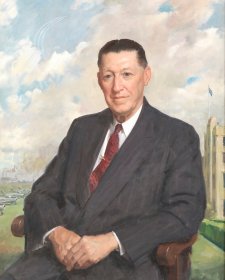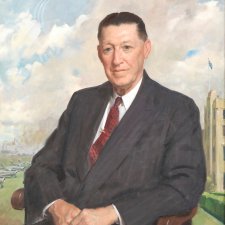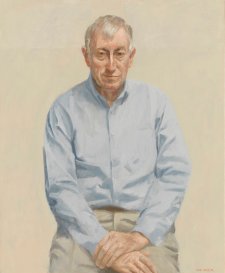- About us
- Support the Gallery
- Venue hire
- Publications
- Research library
- Organisation chart
- Employment
- Contact us
- Make a booking
- Onsite programs
- Online programs
- School visit information
- Learning resources
- Little Darlings
- Professional learning
Sir Lawrence Wackett KBE DFC AFC (1896–1982), aircraft designer, pilot and entrepreneur, was educated at Duntroon Military Academy and chosen as a member of the newly formed Australian Flying Corps. In World War I he served in Palestine and Europe, and was noted for his courageous actions and innovative methods, making, for example, an aircraft machine gun out of parts from a Singer sewing machine he bought in Port Said. During his service, he played key roles in the Battle of Hamel and the dismantling of the Hindenberg Line; he was promoted to Major and decorated for bravery under fire. In 1923, Wackett retired from operations to study aircraft design, heading an agency known as the RAAF Experimental Station to produce aircraft in Australia. Wackett designed the Widgeon I and II flying-boat in 1924 as well as the Warragal I and II landplanes. As head of the new Commonwealth Aircraft Corporation from 1936, Wackett designed the Wirraway fighter, of which more than 700 units were produced. Mustangs, Sabres and Mirages were produced under license at CAC’s Melbourne premises, as well as a practice plane for the Empire Air Training Scheme, the Wackett Trainer. Wackett was knighted for his services to aviation in 1954 and received the Oswald Watt Gold Medal in 1974. A keen angler, he wrote two books about trout fishing before Aircraft Pioneer: an Autobiography (1972).
Sir William Dargie (1912–2003) painted dozens of leaders in industry and business over his long career, including Wackett’s friends Essington Lewis and Harold Darling. The perspective in the portrait of Wackett is idiosyncratic. He sits in a boardroom or drawing-room chair, but he is in the open air; the façade of the Commonwealth Aircraft Corporation’s main building, in which his office was actually located, is below him on the right. The building now houses RMIT’s Sir Lawrence Wackett Centre for Aerospace Design Technology.
Gift of Arlette Perkins daughter of Sir Lawrence Wackett 2009. Donated through the Australian Government's Cultural Gifts Program.
© Roger Dargie and Faye Dargie
Sir William Dargie CBE (age 49 in 1961)
Sir Lawrence Wackett KBE DFC AFC (age 65 in 1961)
Roger Perkins (1 portrait)



On one level The Companion talks about the most famous and frontline Australians, but on another it tells us about ourselves.



Aircraft designer, pilot and entrepreneur, Sir Lawrence Wackett rejoins friends and colleagues on the walls of the National Portrait Gallery.



Scientists tend to conjure up images of men in white coats in labs but this is just one stereotype in an evolving history of how we have perceived scientists, and how their profession has been understood over the years.